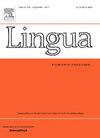Is there a polarity-prominent language? A typological perspective on Dagaare verbal systems
IF 1.3
3区 文学
0 LANGUAGE & LINGUISTICS
引用次数: 0
Abstract
To date, the three-tier typology of verbal systems into tense-prominent, aspect-prominent and mood-prominent proposed by Shankara Bhat at the end of the twentieth century seems to have stuck. The present study reveals a novel type of prominence in Dagaare (Niger-Congo: Mabia/Gur), namely polarity prominence. The study shows that distinctions in tense, mood and modality are cast in terms of polarity. First, the tense category of futurity makes positive and negative distinctions in both future and non-future. Second, indicative and imperative moods are essentially distinguished by polarity markers unique to each mood, and the sub-types of each mood are shades of polarity. This polarity-based mood distinction extends beyond the verbal domain to the domain of clause final particles and focus marking, establishing polarity concord between items of the verbal group and periphery elements of the clause. In addition, the interaction between polarity and modality enacts a cline of polarity from full positivity to full negation with a median modality in the mid region. The study also demonstrates that, although Dagaare verb morphology encodes perfective/imperfective aspectual distinction, aspect is not a competing candidate for prominence in the language. The study reveals that a robust empirical framework of prominence needs to go beyond verbal inflection and as well incorporate finiteness into the criteria of prominence.
有没有一种极端突出的语言?Dagaare语言系统的类型学研究
到目前为止,Shankara Bhat在20世纪末提出的语言系统的三层类型,即时态突出,方面突出和情绪突出,似乎仍然存在。本研究揭示了Dagaare(尼日尔-刚果:Mabia/Gur)的一种新型日珥,即极性日珥。研究表明,时态、语气和情态的区别是根据极性来表现的。首先,将来时的时态范畴对将来时和非将来时进行了肯定和否定的区分。第二,指示语气和祈使语气本质上是由每个语气特有的极性标记来区分的,每个语气的子类型都是极性的阴影。这种基于极性的语气区分从动词性领域扩展到子句末助词和焦点标记领域,在动词性组项和子句外围元素之间建立极性协调。此外,极性和模态之间的相互作用使极性从完全正性到完全负性发生变化,中间区域有一个中间模态。该研究还表明,尽管Dagaare动词形态编码了完成/不完成的方面区分,但方面并不是语言中突出的竞争候选人。研究表明,一个强大的突出的经验框架需要超越语言的变化,并将有限性纳入突出的标准。
本文章由计算机程序翻译,如有差异,请以英文原文为准。
求助全文
约1分钟内获得全文
求助全文
来源期刊

Lingua
Multiple-
CiteScore
2.50
自引率
9.10%
发文量
93
审稿时长
24 weeks
期刊介绍:
Lingua publishes papers of any length, if justified, as well as review articles surveying developments in the various fields of linguistics, and occasional discussions. A considerable number of pages in each issue are devoted to critical book reviews. Lingua also publishes Lingua Franca articles consisting of provocative exchanges expressing strong opinions on central topics in linguistics; The Decade In articles which are educational articles offering the nonspecialist linguist an overview of a given area of study; and Taking up the Gauntlet special issues composed of a set number of papers examining one set of data and exploring whose theory offers the most insight with a minimal set of assumptions and a maximum of arguments.
 求助内容:
求助内容: 应助结果提醒方式:
应助结果提醒方式:


